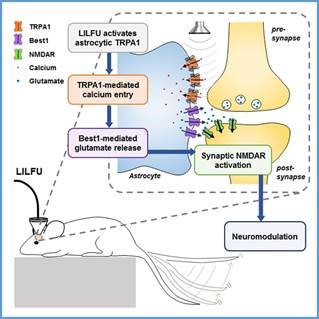Neuromodulation is the reversible stimulation or suppression of neural brain activity and has been extensively studied with transcranial ultrasound stimulation (TUS). Instead of using high-intensity focused ultrasound for ablation of targets, a form of TUS can take neurons that are “sleeping” and wake them up – or take neurons that are firing too much, such as in epilepsy, and slow them down. Neuromodulation uses low-intensity, low-frequency ultrasound (LILFU) to create mild mechanical waves on cell membranes which are transmitted into electrical signals that regulate cellular functions. Until now, the exact underlying mechanisms were unclear.
 A recent publication by Lee and colleagues has elucidated a main mechanism describing how TUS alters neuronal function entitled, “Ultrasound Neuromodulation via Astrocytic TRPA1”. It details the pathway of how LILFU alters calcium permeability in the astrocytes, supporting cells of the brain, releasing chemical neurotransmitters that in turn activate adjacent neurons.
A recent publication by Lee and colleagues has elucidated a main mechanism describing how TUS alters neuronal function entitled, “Ultrasound Neuromodulation via Astrocytic TRPA1”. It details the pathway of how LILFU alters calcium permeability in the astrocytes, supporting cells of the brain, releasing chemical neurotransmitters that in turn activate adjacent neurons.
Another publication by Fouragnan et al. published in Nature Neuroscience has expanded our understanding of how different brain areas influence decision making. A key difference that distinguishes this study from previous experiments is that the authors recorded neuronal activity from multiple brain areas simultaneously and during the decision making process. They found that some brain areas simply hold information, whereas others actually influence behavior. The results of this paper support individualized targeted therapy that can be tailored based on patients’ brain activity in various disease states, including anorexia nervosa, obsessive-compulsive disorder, and Tourette’s syndrome.
Photo courtesy of Lee, et. al.
